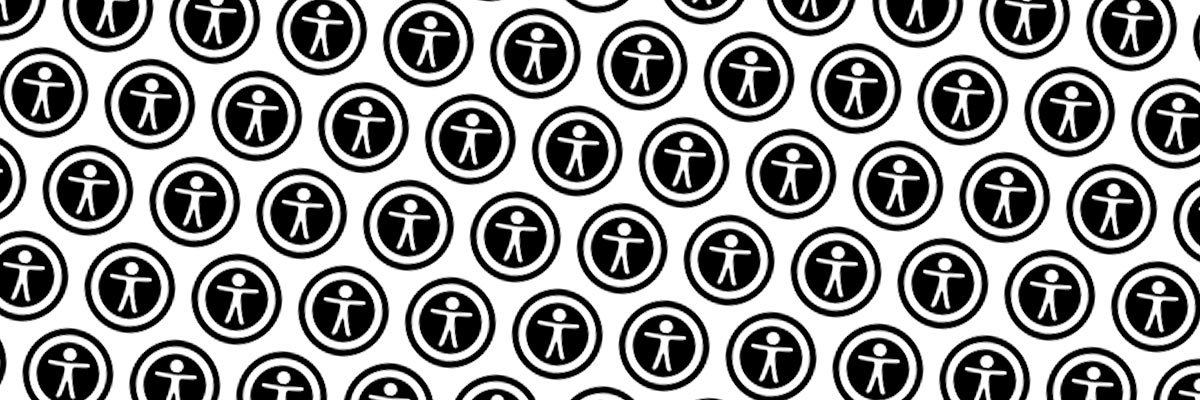Close your eyes and imagine trying to use this website without looking at it. Not so easy, eh? Imagine using only one hand with your keyboard. What would YouTube be like if you couldn't hear? This is the reality of millions of people with disabilities.
According to the Census Bureau...
- 19.9 million (8.2%) have difficulty lifting or grasping.
This could impact the use of a mouse or keyboard. - 15.2 million (6.3%) have a cognitive, mental, or emotional impairment.
- 8.1 million (3.3%) have a vision impairment.
These people might rely on a screen magnifier or a screen reader, or have a form of color blindness. - 7.6 million (3.1%) have a hearing impairment.
They might rely on transcripts or captions for audio and video media.
This is the reason that guidelines such as the WCAG exist.
WCA-What?
Let's back up. In 1990, the the Americans with Disabilities Act was passed, which made discrimination against people with disabilities illegal. Since then, court cases have determined that these protections also apply to websites and Internet services.
In response to the passing of the ADA, the Worldwide Web Consortium — the main international standards organization for the Internet — created the Web Content Accessibility Guidelines, the WCAG.
While failure to make a website accessible isn't expressly illegal, it has every potential to be codified into law. Recently, there has been a focus on ensuring website accessibility in education, healthcare, and financial institutions.
Accessibility is, simply, the inclusive practice of removing barriers that prevent interaction with, or access to websites, by people with disabilities.
About the WCAG
The most recent version of these guidelines, 2.0, were finalized and published by the W3C in 2008. It has twelve guidelines and four principles that web developers should follow...
Perceivable
Information and user interface components must be presentable to users in ways they can perceive.
- Guideline 1.1
Provide text alternatives for any non-text content so that it can be changed into other forms people need, such as large print, braille, speech, symbols or simpler language. - Guideline 1.2
Time-based media: Provide alternatives for time-based media. - Guideline 1.3
Create content that can be presented in different ways (for example simpler layout) without losing information or structure. - Guideline 1.4
Make it easier for users to see and hear content including separating foreground from background.
Operable
User interface components and navigation must be operable.
- Guideline 2.1
Make all functionality available from a keyboard. - Guideline 2.2
Provide users enough time to read and use content. - Guideline 2.3
Do not design content in a way that is known to cause seizures. - Guideline 2.4
Provide ways to help users navigate, find content, and determine where they are.
Understandable
Information and the operation of user interface must be understandable.
- Guideline 3.1
Make text content readable and understandable. - Guideline 3.2
Make web pages appear and operate in predictable ways. - Guideline 3.3
Help users avoid and correct mistakes.
Robust
Content must be robust enough that it can be interpreted reliably by a wide variety of user agents, including assistive technologies.
- Guideline 4.1
Maximize compatibility with current and future user agents, including assistive technologies.
The WCAG also specifies levels of conformance to the standards: A, AA, and AAA
These standards can affect overall site design and structure as well as page content such as text, images, color contrasts and sounds. When sites are correctly designed, developed and edited, all users have equal access to information and functionality.
We do it. And so should you.
This year, Pleth has been in the process of developing a comprehensive accessibility application that routinely scans the websites we develop. The app allows us to fix any noncompliant pages, according to WCAG 2.0 AA standards. It also creates documentation of the work we do and places a widget on the website (which you can see in the bottom right corner of this page).
During website development, content will be audited, corrected, and migrated to the new website during development. Once the site is ready for launch, a final scan will be completed with any subsequent fixes finalized prior to launch, and the newly launched site will display.
Existing sites can be audited and remediated as well. This starts with an initial audit of all of the existing pages and is followed up by a routine audit of every page that content is changed on from that point forward. This ensures the site is kept compliant as users make changes.
This addition to our development process will ensure that we're providing the best possible experience for the users of our websites and we're excited to finally share it.
